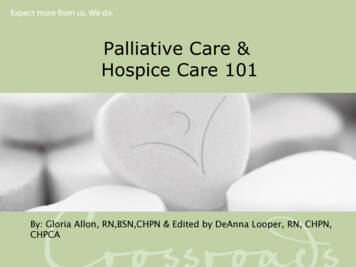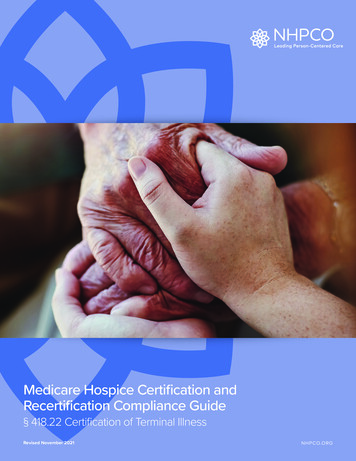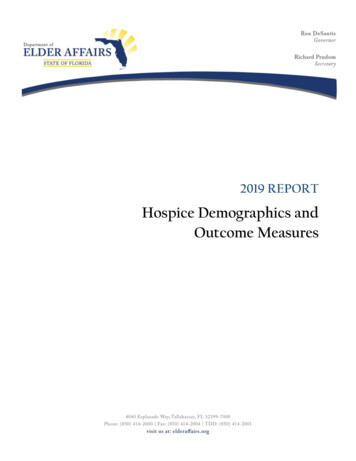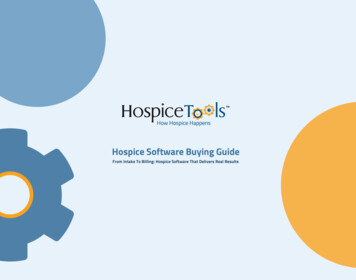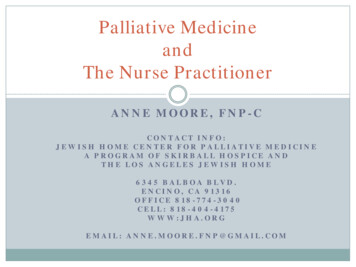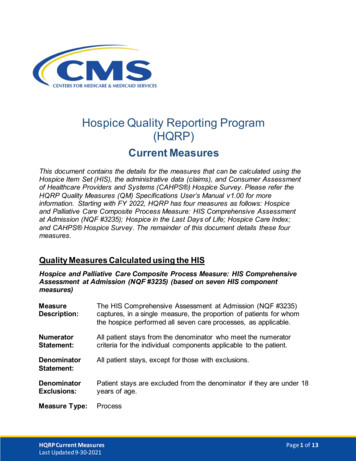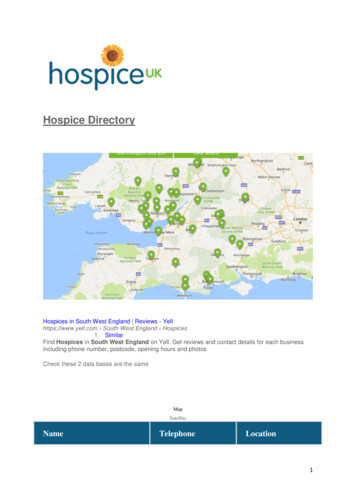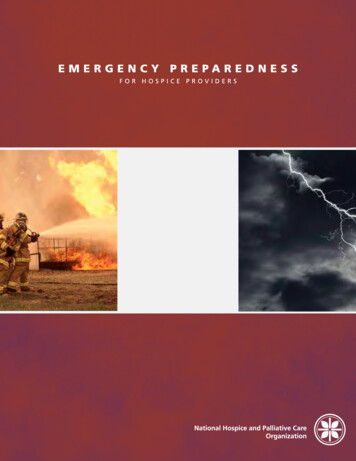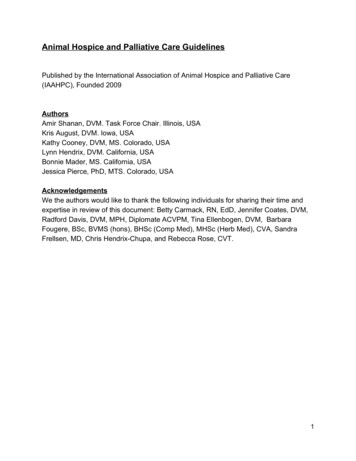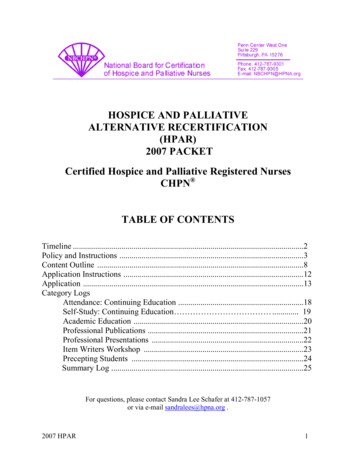
Transcription
HOSPICE AND PALLIATIVEALTERNATIVE RECERTIFICATION(HPAR)2007 PACKETCertified Hospice and Palliative Registered NursesCHPN TABLE OF CONTENTSTimeline .2Policy and Instructions .3Content Outline .8Application Instructions .12Application .13Category LogsAttendance: Continuing Education .18Self-Study: Continuing Education . 19Academic Education .20Professional Publications .21Professional Presentations .22Item Writers Workshop .23Precepting Students .24Summary Log .25For questions, please contact Sandra Lee Schafer at 412-787-1057or via e-mail sandralees@hpna.org .2007 HPAR1
HOSPICE AND PALLIATIVE ALTERNATIVE RECERTIFICATION(HPAR)TIMELINEDATE OF LASTCERTIFICATIONCERTIFICATIONEXPIRESHPAR ELIGIBLEYEARPOINT ACCRUALPERIODAPPLICATION ANDFEES TO NBCHPN TO BE RECEVIEDBY:ALL APPLICATIONSREVIEWED BY:CANDIDATESNOTIFIED OFAPPROVAL/DENIALAPPLICANTSSELECTED FORAUDIT NOTIFIEDBY:AUDITS DUE INNATIONAL OFFICEAUDIT OUTCOMESNOTIFICATIONLETTER OF INTENTFOR WRITTENEXAM DUE INNATINAL OFFICE2003200420052006December 31,20072007, 2015,every 8 yearsthereafterJanuary 2003 –December 31,2006March 1, 2007December 31,20082008, 2016,every 8 yearsthereafterJanuary 2004 December 31,2007March 1, 2008December 31,20092009, 2017,every 8 yearsthereafterJanuary 2005 –December 31,2008March 1, 2009December 31,20102010, 2018every 8 yearsthereafterJanuary 20068December 31,2009March 1, 2010April 15, 2007April 15, 2008April 15, 2009April 15, 2010May 1, 2007May 1, 2008May 1, 2009May 1, 2010May 1, 2007May 1, 2008May 1, 2009May 1, 2010June 1, 2007June 1, 2008June 1, 2009June 1, 2010July 1, 2007July 1, 2008July 1, 2009July 1, 2010July 15, 2007July 15, 2008July 15, 2009July 15, 2010March 1HPAR Application due in National OfficeMarch 15Receipt notification forwarded to candidatesMay 1Notice of Approval/Audit/DisapprovalJune 1Audit returns due to National OfficeJuly 1Audit outcome notificationJuly 15Written examination letter of intent due in National OfficeAugust 12007 HPARWritten examination application deadline2
NBCHPN Hospice and Palliative Nurses Alternative Recertification (HPAR)Policy and InstructionsUnderlying Assumptions of Alternative Renewal of Certification MethodAll activities undertaken in the process of renewal of certification by the alternative methodshould extend knowledge of and improve the practice of hospice and palliative nursing. Theseactivities provide an opportunity to demonstrate remediation in competency areas whereprevious test scores were the lowest. In addition, these activities should be consistent with thescope of hospice and palliative nursing practice as stated in the HPNA Statement of the Scopeand Standards of Hospice and Palliative Nursing Practice and the vision and mission ofNBCHPN .HPAR policy, application and log forms are reviewed each Spring by the NBCHPN Boardof Directors. There may be revisions to the documents. Please assure that you are usingthe policy, application and log forms dated (in the bottom left corner) for the year in whichyou are applying for HPAR.Renewal Options1. After becoming certified or recertified by taking the examination, a candidate may choseto use the alternative method for renewal of certification for the next renewal cycle.2. Renewal by examination will be required every other time a candidate is due forrecertification.3. Renewal of certification by taking the examination will be an available option each time acandidate is due for recertification.4. The fee for renewal of certification will be the same regardless of method chosen forrenewal.Alternative Method1. The candidate must earn a total of 100 points during the alternative certification renewalperiod, by completing activities in the categories of professional development specifiedby NBCHPN . Candidates are not required to submit points in every category.2. All 100 points must be earned through activities that provide content specific to or withdirect application to hospice, palliative, or end-of-life care. For the present, an exceptionwill be made for activities in the category of Academic Education. In addition,candidates will be required to document the correlation of EACH activity with thecontent outline of the certification examination. Activities that are for general nursing(i.e., CPR, ACLS) will not be accepted.2007 HPAR3
3. Accrued points may be distributed across all categories of professional activities, with theexception of Continuing Nursing Education. All 100 points may be earned in thiscategory alone. Some limitations are imposed on the number of points that may beaccrued through certain activities in all of the other categories.4. Candidates are required to submit with their application, the category logs that delineatetheir participation in activities for point accrual. Each activity must correspond to theTest Content Outline (by domain Number and Letter). Refer to page 8 under “TestContent Outline.”5. A percentage of applications will be selected each year for audit. Candidates whoseapplications are selected will be required to submit additional documentation regardingpoint accrual activities. Refer to the documentation section of each category.6. Point accrual is 4 (four) complete years. It begins in JANUARY of the year ofcertification, regardless of which month the exam was successfully completed. Accrualends in DECEMBER of the year PRIOR to the year of expiration.Point Accrual Categories1. Continuing Nursing Education Through attendance at live programs which award contact hours offered by anaccredited provider.A program in which the presenter(s) is available for comments/questions “at thetime of the presentation”, (ie, audio teleconference or website teleconference) isconsidered a program of “attendance”.Audiotapes, CD-ROMs or online programs completed “after” the livepresentation are considered self-study. Through self-study educational activities, either in print or online, which awardcontact hours offered by an accredited provider. Points accrued through self-study are limited to 50% (maximum 50 points) of totalaccrued points. Live or self-study activities must be approved for contact hours by an organization,which is accredited by American Nurses Credentialing Center Commission onAccreditation (ANCC COA), National League for Nursing (NLN), State NursesAssociation and only those State Boards of Nursing that have a system for the formalapproval of continuing education providers. Refer to page 5 and 6. Continuing Medical Education (CME) and Continuing Education (CE) awardedthrough attendance at programs offered by other disciplines (e.g. physicians, socialworkers), which have been approved for an attendance certificate, will be accepted.However, points earned through CMEs and other disciplines must be limited to 10%(maximum 10 points) of total accrued points. Points are awarded:One 50 minute contact hour 1 pointOne 60 minute CME hour 1.2 pointsOne point will be awarded for each CE regardless of the source.2007 HPAR4
Documentation: (Records kept by certificant unless audited)Certificate awarded by the provider, which states the participant name, the activitythat has been approved for contact hours, the name of the approval organization, thedate of the activity, and the number of hours awarded.Contact Hours for continuing education (e.g., workshops, seminars, independent study) must beprovided by an agency, organization, or institution that has successfully gone through anaccreditation review demonstrating its capacity to provide continuing education.The following organizations are acceptable to NBCHPN to grant approval to providers ofcontact hours:Approval Bodies State Nurses Associations, Specialty Nursing Organizations, or Federal Nursing Servicesthat have been accredited by the American Nurses Credentialing Center Commission onAccreditation (ANCC COA) as approvers of Continuing Nursing Education (see theANCC website for list of names, www.nursingworld.org/ANCC). National League for Nursing (NLN) State Boards of Nursing that have a system for the approval of continuing educationproviders. (Alabama, California, Florida, Iowa, Kansas, Kentucky, Louisiana, Nevada,Ohio, and West Virginia)** Several state boards of nursing require continuing education for renewal of RNlicensure. However, not all of these state boards require that the continuing education beapproved or provided by an approved provider. Therefore, some continuing educationprograms may be acceptable for candidate relicensure in their state but NOT acceptablefor renewal of certification through HPAR by NBCHPN .The following types of organizations are acceptable to NBCHPN to provide contact hours:Providers Agencies, organizations, or institutions that have been accredited by ANCC COA asproviders of continuing nursing education.Wording on CE certificate:ABC Institution is accredited as a provider of continuing nursing education by the ANCCCOA. Agencies, organizations, or institutions that have been approved by state nursingorganizations or specialty nursing organizations to provide continuing nursing education.Wording on CE certificate:2007 HPAR5
ABC Agency is approved as a provider of continuing nursing education by XYZNursing Association, which is an accredited approver of continuing education innursing by the ANCC COA.ORThis activity for 7.0 contact hours has been approved by XYZ Nursing Association,which is an accredited approver of continuing nursing education by the ANCC COA.ORThis activity for 7.0 contact hours has been approved by the XYZ State Board ofNursing which is an accredited approver of continuing nursing education by theNational League of Nursing.2. Academic Education Through completion of courses that are required for a nursing major OR other coursesthat address the biopsychosocial knowledge base of professional human service You must call National Office at 412-787-1057 for pre-approval of course BEFOREsubmission of the HPAR packet. Enrollment in a degree program is not required Courses must be provided by accredited colleges or universities A grade of “C” or higher must be achieved for a course Points awarded:One academic credit 15 points Limited to a maximum of 45% (45 points) of total accrued points Documentation: (Records kept by certificant unless audited)Grade reports and course descriptions3. Professional Publications Through items published in books, journals, professional newsletters, or electronicmedia (e.g., CD-ROM, video) Publications done as part of fulfillment of routine job expectations are NOT acceptable Must be the author, co-author, editor, or co-editor Publication must have been accepted for publication during renewal period even if actualpublication date is past renewal period. Points awarded:Doctoral dissertation 75 pointsAuthored textbook ( 300 pages) 60 pointsAuthored textbook ( 300 pages) 40 pointsTextbook editor 20 pointsChapter in a book 15 pointsBook review 5 pointsEditorial in professional journal 2 pointsColumn in a professional journal 2 points (maximum 8 points)Educational pamphlet 5 points2007 HPAR6
Article in professional organization newsletter 2 pointsResearch abstract 2 pointsOriginal research article (published as single or primary author in a peer reviewedjournal) 15 pointsOriginal journal article (published as single or primary author in a peer reviewed journal) 10 pointsLimited to a maximum of 75% (75 points) of total accrued pointsDocumentation: (Records to be kept by certificant unless audited)Copies of articles, editorial, abstracts, and book reviews. For other publications – titlepage and table of contents where the candidate name is given as author. Copy of thepublisher notification of acceptance if publication date occurs after submission ofrenewal application.4. Professional Presentations Through formal structured educational presentations made to nurses, other healthcareproviders, or the public (e.g., seminars, conferences, in-services, public education) Presentations given as part of fulfillment of routine job expectations are not acceptable Points awarded based on presentation time.Each presentation must be at least 50 minutes in length - 50 minutes 5 pointsPoster presentations 2 points Limitations:o Points can be earned for only ONE presentation of the same materialo Points are limited to a maximum of 20% (20 points) of total points accrued Documentation: (Records kept by certificant unless audited)Copy of program which lists information about presentation, including date, name ofcandidate, title of presentation, and content5. Item Writer’s Workshop Participation Through attendance and participation at an NBCHPN Item Writer’s Workshop for theCertification Examination for Hospice and Palliative Nurses, LicensedPractical/Vocational Nurses or Nursing Assistants Candidates must attend the entire workshop and participate in the refinement and creationof items for submission to NBCHPN for future use on certification examinations Points awardedAttendance at one workshop 10 points Limitations:Points awarded for participation in no more than 2 item writer’s workshops during thecandidate renewal periodIf CE’s are offered for any individual workshop, they may not be used to earn pointstoward renewal of certification Documentation: (Records kept by certificant unless audited)Certificate of participation2007 HPAR7
6. Precepting Students Through precepting students of ANY discipline enrolled in a formal education program.The precepting should be in a one-on-one relationship with specific goals to learninformation about the specialty of hospice and palliative care. Nursing students must beenrolled in an accredited nursing education program. Points awarded:25 hours of precepting 5 pointsPrecepting hours MUST be cumulative (over the four years) to 25 or 50 hoursfor 5 or 10 points respectively.Precepting points in increments other than 5 or 10 WILL NOT BE ACCEPTED Limitations:Maximum of 10% (10 points) of total accrued. Documentation: (Records kept by certificant unless audited)Complete Precepting Audit Form signed by the faculty member supervising thestudent(s). The Precepting Audit Form is required only if audited. The form includes thestudent(s) educational program documenting number of students, dates of preceptorship,number of combined hours and goals. One form can be used for multiple students withthe same faculty/instructor.Detailed Test Content Outline(Domain Number and Letter)TEST CONTENT OUTLINEDOMAIN with Test Item Distribution1.1. Patient Care: End-stage DiseaseProcess in Adult PatientsItems152. Patient Care: Pain ManagementItems383. Patient Care: Symptom ManagementItems374. Care of Patient and FamilyItems155. Education and AdvocacyItems156. Interdisciplinary/CollaborativePracticeItems157. Professional IssuesItems152007 HPARPatient Care: End-stage Disease Process inAdult PatientsA. Identify and respond to indicators ofimminent deathB. Identify specific patterns of diseaseprogression, complications, andtreatment for:1. altered immune disease (e.g.,AIDS)2. neoplastic and paraneoplasticconditions (e.g., cancer andassociated complications)3. neurological conditions4. cardiac conditions5. pulmonary conditions6. renal conditions7. gastrointestinal and hepaticconditions8. general debility (e.g., failure tothrive)9. dementia10. endocrine disorders8
2.Patient Care: Pain ManagementA. Assessment1. Perform comprehensive assessmentof pain2. Identify etiology of pain3.Identify types of pain or painsyndromes4. Identify factors that may influencethe patient’s experience of paina. fearb. depressionc. despaird. cultural issuese. spiritual issuesB. Pharmacologic Interventions1. Recommend medicationsappropriate to severity and specifictype of paina. routesb. schedulingc. titrationd. breakthrough doses2. Administer analgesic medications3. Identify dosage equivalents whenchanging analgesics or route ofadministration4. Administer adjuvant medications(e.g., NSAIDS, corticosteroids,anticonvulsants)5. Respond to medication side effects,interactions, or complications6. Identify and facilitate assessment ofthe need for palliativeantineoplastic therapy7. Perform or manage palliativesedation (i.e. total sedation)C. Nonpharmacologic Interviews1. Respond to psychosocial andspiritual issues related to pain2. Identify and facilitate assessment ofthe need for palliative radiation3. Recommend and implementnonpharmacologic interventionsD. Evaluation1. Assess for medication side effects,interactions or complications2. Assess for side effects of radiationtherapy3. Assess for side effects ofantineoplastic therapy4. Evaluate efficacy of pain reliefinterventions2007 HPAR3.Patient Care: Symptom ManagementA. Neurological1. aphasia2. dysphagia (difficulty swallowing)3. lethargy or sedation4. myoclonus (spasms of a muscle orgroup of muscles)5. paresthesia or neuropathies6. seizures7. extrapyramidal symptoms8. changes in intracranial pressureB. Cardiovascular1. hematologic problems2. edema3. hypothermia4. syncope5. anginaC. Respiratory1. congestion (lung or terminal excessrespiratory secretions)2. cough3. dyspnea or terminal breathlessnessD. Gastrointestinal1. constipation2. diarrhea3. bowel incontinence4. ascites5. hiccoughs6. nausea or vomiting7. bowel obstructionE. Genitourinary1. bladder spasms2. urinary incontinence3. urinary retentionF. Musculoskeletal1. impaired mobility or complicationsof immobility2. pathological fractures3. weakness or activity intoleranceG. Skin and Mucous Membrane1. dry mouth2. oral lesions3. pruritis4. wounds, including pressure ulcersH. Psychosocial, Emotional, and Spiritual1. anger or hostility2. anxiety3. denial4. depression5. fear6. grief7. guilt8. impaired communication9. loss of hope or meaning10. near death awareness11. sleep disturbances9
12. spiritual distress or unresolvedspiritual issues13. suicidal or homicidal ideation14. unresolved interpersonal matters15. sexual/intimacy issuesI. Nutritional and Metabolic1. anorexia2. cachexia or wasting3. dehydration4. electrolyte imbalance (e.g.,hypercalcemia, hyperkalemia)5. fatigueJ. Immune System1. infection or fever2. myelosuppression (i.e., anemia,neutropenia, thrombocytopenia)K. Mental Status Changes1. agitation or terminal restlessness2. confusion3. delirium4. dementia5. hallucinationsL. Lymphedema4.Care of Patient and FamilyA. Resource Management1. Explain Medicare and Medicaidhospice benefits2. Explain care options possible underprivate insurance benefit plans3. Inform patient/family how toaccess 24-hours a day: services,medications, equipment, supplies4. Modify the plan of care toaccommodate socioeconomicfactors5. Assess and respond toenvironmental and safety risks6. Advise on adaptation of thepatient’s home environment forsafety7. Monitor disposal ofsupplies/equipment (e.g., syringes,needles)8. Monitor Schedule II drugs (e.g.,use, abuse, destroy at time of death)B. Psychosocial, Spiritual, and Cultural1. Assess and respond to spiritualneeds2. Assess and respond topsychological and emotional status3. Assess and respond to familysystems and dynamics4. Modify the plan of care toaccommodate cultural values andbehaviors2007 HPARC. Grief and Loss1. Encourage life review2. Counsel or provide emotionalsupport regarding grief and loss foradults3. Counsel or provide emotionalsupport regarding grief and loss forchildren4. Provide information regardingfuneral practices/preparation5. Provide death vigil support6. Visit at time of death to facilitatepronouncement, notification andtransportation7. Facilitate transition intobereavement services8. Participate in formal closureactivity (e.g., visit, call, card)5.Education and AdvocacyA. Caregiver Support1. Teach primary caregivers specifictechniques for patient care (e.g.,colostomy)2. Monitor primary caregiver’s abilityto provide care3. Monitor care for neglect and abuse4. Access appropriate resources tomeet the needs of patient andfamily5. Promote family self-care activitiesB. Education1. Identify and respond to barriers toability to learn2. Teach about the signs andsymptoms of imminent death3. Teach about the end-stage diseaseprocess4. Teach about pain and symptomrelief5. Teach alternative methods of painand symptom relief (e.g., selfhypnosis, distraction, humor,massage, aroma)6. Describe and offer treatmentoptions10
C. Advocacy1. Monitor needs for levels of care orincreased services2. Facilitate effective communicationbetween patient, family, and careproviders3. Identify barriers to communication4. Encourage patient and family indecision making regardingtreatment options (e.g., empowerpatient and family)5. Make referrals for interdisciplinaryteam (IDT) consults6. Participate in advance careplanning (e.g., advance directives,life support, DNR status)7. Assist the patient to maintainoptimal function and quality of lifewithin the limits of the diseaseprocess8. Facilitate self-determined lifeclosure6. Interdisciplinary/Collaborative PracticeA. Coordinate and Supervise1. Coordinate patient care with otherhealth care providers2. Supervise unlicensed personnel(e.g., home health aide, CNA)3. Arrange for medical equipment,supplies, or medications4. Facilitate and coordinate transfer toa different level of care within theMedicare or Medicaid (State)hospice benefit5. Facilitate and coordinate transfer toa different care setting6. Coordinate and monitor volunteeractivitiesB. Collaborate1. Collaborate with patient’s attendingphysician2. Utilize techniques of effectivegroup process3. Evaluate progression of diseaseprocess to verify appropriatenessfor hospice or palliative care4. Encourage family role in IDTdecisions5. Participate in development of anindividualized, interdisciplinaryplan of care for patient/family2007 HPAR7.Professional IssuesA. Practice Issues1. Identify and incorporate standardsinto practice (e.g., HPNA Standardsof Nursing, NHO standards, ANAstandards)2. Identify and incorporate guidelinesinto practice (e.g., AHCPRguidelines, WHO ladder, NHOguidelines)3. Identify and incorporate legalregulations into practice (e.g.,OSHA, HCFA conditions ofparticipation)4. Educate the public on end-of-lifeissues and palliative care5. Participate in evaluatingeducational materials for patientsand family6. Access educational resources frommultimedia sources (e.g., Internet)7. Demonstrate awareness oftechniques of conflict resolution8. Utilize research to influence ordevelop procedures or protocols9. Educate health care providersregarding hospice benefits underMedicare/Medicaid10. Participate in quality assuranceprocessB.Professional Development1. Contribute to professionaldevelopment of peers, colleagues,and others as preceptor, educator,or mentor2. Serve as clinical preceptor forstudent nurses3. Identify strategies to resolveethical concerns related to the endof life4. Participate in peer review5. Maintain professional boundariesbetween patient/family and staff6. Participate in self-care (e.g., stressmanagement)7. Participate in research activities(e.g., data collection)8. Read medical or nursing journalsto remain current in treatmentoptions9. Participate in professional nursingorganization activities10. Maintain personal continuingeducation plan to updateknowledge11
NBCHPN Hospice and Palliative Nurses Alternative Recertification(HPAR)Instructions on completing the HPAR ApplicationRead the HPAR Policy and Instructions before completing application. Retain all required forms ofdocumentation for the four-year period. Audits will be conducted annually.1. Sign application form – signature is required for application to be processed.2. Complete information as requested on all pages. Please write out the full name of anorganization, facility, journal etc. before using an abbreviation or acronym.All information must be completed for application to be processed.3. Complete all applicable category logs (you may make as many copies as are needed.) Followthe sample entry as shown on each form. If incomplete, application will NOT be processed.Remember: All items listed must correspond to the TEST Content Outline to beapplicable. All CEs must be provided by an accredited provider or approver of nursingcontinuing education.4. DO NOT submit CE certificates and other documentation materials with your application.These are only to be submitted if you are audited.5. Submit only those Category Logs for categories in which you are claiming points. Do notsubmit blank logs.6. Complete HPAR SUMMARY LOG. If incomplete, application will NOT be processed.7. Please remember to retain your own copy of your submission packet.8. There will be no refunds for HPAR. Those candidates who are unsuccessful completing theHPAR may apply 50% of their application fee to the Fall testing date of the same year only if arequest is received in the National Office by July 15th of the testing year.9. Utilize the check list on the summary log to assure you have completed all required items –mail items as indicated to be RECEIVED by March 1 to:NBCHPN One Penn Center WestSuite 229Pittsburgh, PA 15276-01002007 HPAR12
NBCHPN HPAR Application (Application must be received by National Office on or before March 1st)Please read the instructions before completing this application. Please print. Illegible, incomplete or unsigned applications will not be processed.Please print legiblyFull Name:LastFirstMiddle NameYour Home Address:Street:CityStateHome Phone: (Workplace:Work Phone: (E-mail Address:)Social Security #:Ext.)Your NBCHPN certification numberFax Number: ()Year you were last certified1.Zip 4Did you certify under a different last name? No YesExpiration dateIf yes, what was the name?In order to obtain HPNA member pricing, you must be an HPNA member on or before February 28th.2.HPAR Renewal Fee: (Please circle the fee appropriate to you) HPNA Members 210 Check enclosed: (Payable to NBCHPN )HPNA Member Number Visa MasterCard Non-HPNA Members 310 DiscoverCard Number:Print name as it appears on credit cardExpiration Date:3 Digit Security Code3. Number of HPAR points earned and recorded on the enclosed SUMMARY LOG PAGE (page 25) (Minimum of 100 POINTS required)2007 HPAR13
DEMOGRAPHIC INFORMATIONPlease complete the following questions, checking only one response for each question, unless directed otherwise.Type of Practice (please check one): Clinical Educational Administrative Research OtherWhat is the highest academic level you have attained? Associate degree in nursing Diploma in nursing Bachelor’s degree (non-nursing) Bachelor’s degree in nursing Master’s degree (non-nursing) Master’s degree in nursing Doctoral degreeProfessional Information:Which of these best describes the nature of your nursing practice? Hospice nurse Palliative nurseTotal number of hours per week do you work in nursing: Less than 8 hrs. 8-16 hrs. 17-24 hrs. 25-32 hrs. 33-40 hrs. 40 hrs.Total number of hours per week do you work specifically in hospice or palliative nursing: Less than 8 hrs. 8-16 hrs. 17-24 hrs. 25-32 hrs. 33-40 hrs. 40 hrs.Total number of years of nursing care: 0-2 yrs. 3-5 yrs. 6-10 yrs. 11-15 yrs. 16-20 yrs. 21-25 yrs. 26-30 yrs. 30 yrs.Total number of years in hospice/palliative nursing care: 0-2 yrs. 3-5 yrs. 6-10 yrs. 11-15 yrs. 16-20 yrs. 21-25 yrs. 26-30 yrs. Location of primary practice facility (please check one):2007 HPAR Urban Rural 30 yrs. Suburban14
Primary role (please check one): Staff nurse without case management responsibilities Staff nurse with case management responsibilities Clinical supervisor/patient care coordinator Manager/Administrator Clinical educator (including staff development) Advanced practitioner (i.e. CNS, NP) Consultant for hospice/palliative care team Faculty/researcher OtherPrimary employer (please check one): Hospice Agency Home Health Agency Hospital or Healthcare System Long-term Facility College/University Self (private practice) Private Physician Practice Ambulatory Care Facility OtherPrimary practice setting (please check one): Private home Nursing home, assisted living or extended care facility Hospital: Palliative care unit Hospital: Hospice unit Hospital: Other unit or scattered beds Freestanding residence or inpatient hospice Clinic Prison I do not routinely see patients OtherCertified in a nursing specialty by any organization other than NBCHPN ? OCN CCRN RN,C RN,CS OtherHow did you hear about HPAR? NBCHPN Mailing Journal of Hospice and Palliative Nursing Other professional journal HPNA Chapter Meeting Internet/Website HPNA or NHPCO national meeting HPNA mailing Colleague Employer OtherOptional Information:Age: 25 yrs. 25-29 yrs. 30-39 yrs. 40-49 yrs. 50-59 yrs. 60-65 yrs. 65 yrs (senior member)Gender: Male FemaleRace: African American/Black Asian/Asian American/Pacific Islander Caucasian Hispanic
scope of hospice and palliative nursing practice as stated in the HPNA Statement of the Scope and Standards of Hospice and Palliative Nursing Practice and the vision and mission of NBCHPN . HPAR policy, application and log forms are reviewed each Spring by the NBCHPN Board of Directors. There may be revisions to the documents.
